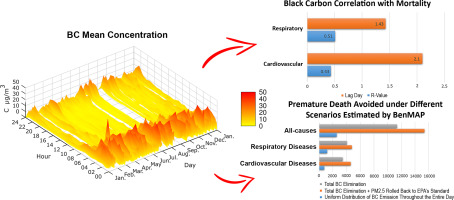当前位置:
X-MOL 学术
›
Sci. Total Environ.
›
论文详情
Our official English website, www.x-mol.net, welcomes your feedback! (Note: you will need to create a separate account there.)
A study of cardiorespiratory related mortality as a result of exposure to black carbon.
Science of the Total Environment ( IF 9.8 ) Pub Date : 2020-04-04 , DOI: 10.1016/j.scitotenv.2020.138422 Kiarash Farzad 1 , Babak Khorsandi 1 , Maziar Khorsandi 2 , Omar Bouamra 3 , Reza Maknoon 1
Science of the Total Environment ( IF 9.8 ) Pub Date : 2020-04-04 , DOI: 10.1016/j.scitotenv.2020.138422 Kiarash Farzad 1 , Babak Khorsandi 1 , Maziar Khorsandi 2 , Omar Bouamra 3 , Reza Maknoon 1
Affiliation

|
INTRODUCTION
Air pollution is a global phenomenon which invariably leads to a serious environmental and health related sequalae. "Black carbon" (BC), a subset of fine particulate matter ≤2.5 μm (PM2.5), is a fossil fuel emission by-product and has more recently been recognized as a major health hazard. The objective of this study is to statistically analyze the BC concentration and its correlation with cardiorespiratory related mortality and to estimate the benefits of BC reduction on the health of the population in the capital city of Tehran.
METHODS
We analyzed the ambient air BC concentration and its correlation with cardiorespiratory related mortality and conducted health impact assessment of BC in Tehran (Jan 2018-Jan 2019). The data pertaining to BC concentration was obtained from Tehran's four major pollution monitoring stations. The mortality data was obtained from Tehran's cemetery registry. We calculated and analyzed BC concentration statistics including the mean, standard deviation, coefficient of variation, skewness, and kurtosis. We then assessed the cross-correlation and temporal relationship (0-7 days) between the daily mean concentration of BC for the entire city and cardiorespiratory related mortality. The BenMAP software was utilized to estimate the potential reduction in cardiorespiratory related mortality rates if BC concentration is reduced. Three hypothetical scenarios were employed in the analysis, utilizing the BenMAP software: (I) BC concentration was completely removed from the ambient air; (II) BC concentration was eliminated, and the remaining (non-BC portion of) PM2.5 concentration was reverted to the United States Environmental Protection Agency (EPA)'s standard level (i.e., 35 μg/m3); and (III) The BC emission during the night (22:00 h-6:00 h, when heavy-duty vehicles (HDVs) are allowed to commute in the city) was distributed throughout the whole day. Since the planetary boundary layer during daytime is much higher than that of nighttime, with the same rate of emission, lower concentrations are spread during the whole day.
RESULTS
The trend of BC concentration variation revealed a persistently higher emission of BC during the nighttime, which is consistent with the large-scale operation of HDVs during these hours in the city of Tehran. We observed a direct correlation between BC concentration and cardiorespiratory related mortality. Analysis also showed a 1.4-day lag period from the time of exposure to BC polluted air and respiratory related deaths, and 2 days for cardiovascular related deaths. As a result, the reduction in BC has significant beneficial effects in reducing potentially preventable cardiorespiratory related mortality. The aforementioned three scenarios for age groups of 30 and above yielded the following results: (I) 11,369 (126 per 100,000 population), (II) 15,386 (171 per 100,000 population), and (III) 2552 (28 per 100,000 population) potentially preventable all-cause (including cardiorespiratory) related deaths annually.
CONCLUSIONS
The BC concentration is relatively high in Tehran and HDVs have a major role in emission of this pollutant. A direct correlation between BC concentration and cardiorespiratory related mortality is observed. There are considerable health benefits in reducing BC concentration in this city. Our findings highlight the urgent need to actively curtail emissions of this harmful pollutant. This can be achieved through utilizing control mechanisms such as particulate filters or amending traffic laws.
中文翻译:

暴露于黑炭导致的心肺相关死亡率的研究。
引言空气污染是一种全球性现象,总是会导致严重的环境和健康相关性角膜溃疡。“黑碳”(BC)是≤2.5μm(PM2.5)的细颗粒物的子集,是化石燃料排放的副产品,最近被认为是对健康的主要危害。这项研究的目的是对BC浓度及其与心肺相关死亡率的相关性进行统计分析,并估计降低BC对首都德黑兰人口健康的好处。方法我们分析了德黑兰(2018年1月至2019年1月)的环境空气中BC浓度及其与心肺相关死亡率的相关性,并进行了BC健康影响评估。有关BC浓度的数据来自德黑兰 四个主要污染监测站。死亡率数据是从德黑兰公墓登记处获得的。我们计算并分析了BC浓度统计数据,包括平均值,标准差,变异系数,偏度和峰度。然后,我们评估了整个城市的BC每日平均浓度与心肺相关死亡率之间的相互关系和时间关系(0-7天)。如果降低了BC浓度,则使用BenMAP软件来估计心肺相关死亡率的潜在降低。利用BenMAP软件,在分析中采用了三种假设情景:(I)从环境空气中完全去除了BC浓度;(II)消除了BC浓度,并保留了PM2的其余部分(非BC部分)。5浓度恢复到美国环境保护局(EPA)的标准水平(即35μg/ m3);(III)夜间(全市允许重型车辆(HDV)上下班)的夜间BC排放量分布)。由于白天的行星边界层比夜晚的行星边界层高得多,因此在相同的排放速率下,全天分布的浓度较低。结果BC浓度变化趋势表明,夜间BC排放量持续增加,这与德黑兰市在这段时间内HDV的大规模运行是一致的。我们观察到BC浓度与心肺相关死亡率之间存在直接关系。分析还显示1。从暴露于BC污染的空气和与呼吸有关的死亡开始到延迟4天,而与心血管相关的死亡则从2天开始。结果,降低BC对降低潜在可预防的心肺相关死亡率具有明显的有益作用。针对30岁及以上年龄段的上述三种情况得出以下结果:(I)11,369(每100,000人口中的126),(II)15,386(每100,000人口中的171)和(III)2552(每100,000人口中的28)每年可预防的全因(包括心肺)相关死亡。结论德黑兰的BC浓度相对较高,而HDV在该污染物的排放中起主要作用。观察到BC浓度与心肺相关死亡率之间存在直接关系。在这个城市降低BC浓度有很大的健康益处。我们的发现强调了迫切需要积极减少这种有害污染物的排放。这可以通过利用控制机制(例如微粒过滤器)或修改交通法规来实现。
更新日期:2020-04-06
中文翻译:

暴露于黑炭导致的心肺相关死亡率的研究。
引言空气污染是一种全球性现象,总是会导致严重的环境和健康相关性角膜溃疡。“黑碳”(BC)是≤2.5μm(PM2.5)的细颗粒物的子集,是化石燃料排放的副产品,最近被认为是对健康的主要危害。这项研究的目的是对BC浓度及其与心肺相关死亡率的相关性进行统计分析,并估计降低BC对首都德黑兰人口健康的好处。方法我们分析了德黑兰(2018年1月至2019年1月)的环境空气中BC浓度及其与心肺相关死亡率的相关性,并进行了BC健康影响评估。有关BC浓度的数据来自德黑兰 四个主要污染监测站。死亡率数据是从德黑兰公墓登记处获得的。我们计算并分析了BC浓度统计数据,包括平均值,标准差,变异系数,偏度和峰度。然后,我们评估了整个城市的BC每日平均浓度与心肺相关死亡率之间的相互关系和时间关系(0-7天)。如果降低了BC浓度,则使用BenMAP软件来估计心肺相关死亡率的潜在降低。利用BenMAP软件,在分析中采用了三种假设情景:(I)从环境空气中完全去除了BC浓度;(II)消除了BC浓度,并保留了PM2的其余部分(非BC部分)。5浓度恢复到美国环境保护局(EPA)的标准水平(即35μg/ m3);(III)夜间(全市允许重型车辆(HDV)上下班)的夜间BC排放量分布)。由于白天的行星边界层比夜晚的行星边界层高得多,因此在相同的排放速率下,全天分布的浓度较低。结果BC浓度变化趋势表明,夜间BC排放量持续增加,这与德黑兰市在这段时间内HDV的大规模运行是一致的。我们观察到BC浓度与心肺相关死亡率之间存在直接关系。分析还显示1。从暴露于BC污染的空气和与呼吸有关的死亡开始到延迟4天,而与心血管相关的死亡则从2天开始。结果,降低BC对降低潜在可预防的心肺相关死亡率具有明显的有益作用。针对30岁及以上年龄段的上述三种情况得出以下结果:(I)11,369(每100,000人口中的126),(II)15,386(每100,000人口中的171)和(III)2552(每100,000人口中的28)每年可预防的全因(包括心肺)相关死亡。结论德黑兰的BC浓度相对较高,而HDV在该污染物的排放中起主要作用。观察到BC浓度与心肺相关死亡率之间存在直接关系。在这个城市降低BC浓度有很大的健康益处。我们的发现强调了迫切需要积极减少这种有害污染物的排放。这可以通过利用控制机制(例如微粒过滤器)或修改交通法规来实现。



























 京公网安备 11010802027423号
京公网安备 11010802027423号